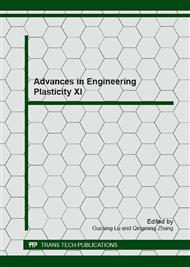[1]
Karlsson, A.M., J.W. Hutchinson, and A.G. Evans, A fundamental model of cyclic instabilities in thermal barrier systems. Journal of the Mechanics and Physics of Solids, 2002. 50(8): pp.1565-1589.
DOI: 10.1016/s0022-5096(02)00003-0
Google Scholar
[2]
Karlsson, A.M., C.G. Levi, and A.G. Evans, A model study of displacement instabilities during cyclic oxidation. Acta Materialia, 2002. 50(6): pp.1263-1273.
DOI: 10.1016/s1359-6454(01)00403-7
Google Scholar
[3]
W.X. Zhang, X.L. Fan, and T.J. Wang, The surface cracking behavior in air plasma sprayed thermal barrier coating system incorporating interface roughness effect. Applied Surface Science, 2011.258: pp.811-817.
DOI: 10.1016/j.apsusc.2011.08.103
Google Scholar
[4]
Olsson, M., A.E. Giannakopoulos, and S. Suresh, Elastoplastic Analysis of Thermal Cycling - Ceramic Particles in a Metallic Matrix. Journal of the Mechanics and Physics of Solids, 1995. 43(10): pp.1639-1671.
DOI: 10.1016/0022-5096(95)00046-l
Google Scholar
[5]
Cheng, J., et al., Thermal/residual stress in an electron beam physical vapor deposited thermal barrier coating system. Acta Materialia, 1998. 46(16): pp.5839-5850.
DOI: 10.1016/s1359-6454(98)00230-4
Google Scholar
[6]
Ambrico, J.M., M.R. Begley, and E.H. Jordan, Stress and shape evolution of irregularities in oxide films on elastic-plastic substrates due to thermal cycling and film growth. Acta Materialia, 2001. 49(9): pp.1577-1588.
DOI: 10.1016/s1359-6454(01)00059-3
Google Scholar
[7]
Karlsson, A.M. and G. Evans, A numerical model for the cyclic instability of thermally grown oxides in thermal barrier systems. Acta Materialia, 2001. 49(10): pp.1793-1804.
DOI: 10.1016/s1359-6454(01)00073-8
Google Scholar
[8]
Kang, K.J. and C. Mercer, Creep properties of a thermally grown alumina. Materials Science and Engineering a-Structural Materials Properties Microstructure and Processing, 2008. 478(1-2): pp.154-162.
DOI: 10.1016/j.msea.2007.05.114
Google Scholar
[9]
Evans, A.G., M.Y. He, and J.W. Hutchinson, Mechanics-based scaling laws for the durability of thermal barrier coatings. Progress in Materials Science, 2001. 46(3-4): pp.249-271.
DOI: 10.1016/s0079-6425(00)00007-4
Google Scholar


